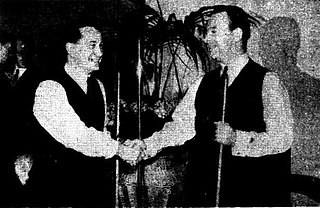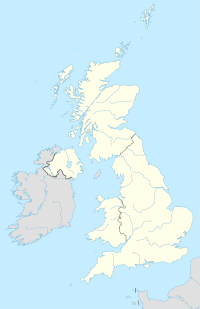The 1969 World Snooker Championship was a professional snooker tournament. It was the first World Snooker Championship in a knock-out format since 1957, following a series of challenge matches from 1964 to 1968. John Spencer won the title, defeating Gary Owen by achieving a winning margin at 37 frames to 24 in the final. Spencer had earlier eliminated defending champion John Pulman from the competition, in the quarter-finals.
The 1928 World Snooker Championship was a professional snooker tournament held at various venues from 28 December 1927 to 17 May 1928. It was the second staging of the World Snooker Championship. It was played on a challenge basis with the other six entrants playing off for the right to challenge defending champion Joe Davis in the final. The final was held at the Camkin's Hall in Birmingham, England, with three of the other matches contested there, and one each played in Leamington Spa and Nottingham.
The 1929 World Snooker Championship, known at the time as the Professional Championship of Snooker, was a snooker tournament held between 17 December 1928 and 7 March 1929 at various venues in England, with the final taking place from 4 to 7 March 1929 at the Lounge Hall, Nottingham. Defending champion Joe Davis won the title for the third time by defeating Tom Dennis by 19 frames to 14 in the final, after securing a winning margin at 17–12.
The 1930 World Snooker Championship, known at the time as the Professional Championship of Snooker, was a snooker tournament held between 17 March and 23 May 1930 at various venues in England, with the final taking place from 19 to 24 May at Thurston's Hall, London. Defending champion Joe Davis won the title for the fourth time by defeating Tom Dennis by 25 frames to 12 in the final.
The 1931 World Snooker Championship was a snooker tournament held at the Lounge Hall in Nottingham, England from 27 April to 1 May 1931. Despite increasing interest in the game of snooker, only two players entered the competition for the title: defending champion Joe Davis and three-times runner-up Tom Dennis. It was the fifth time that the World Snooker Championship had been contested since its inception in 1927. Davis won his fifth World title by defeating Dennis 25–21. Dennis led 19–16 at one stage but Davis won 9 of the next 11 frames to take the title. The highest break of the match was 72, compiled by Davis in the 41st frame.
The 1932 World Snooker Championship, known at the time as the Professional Championship of Snooker, was a professional snooker tournament that took place from 14 to 20 April 1932, with the final being held at Thurston's Hall in London, England. It is recognised as the sixth edition of the World Snooker Championship. The defending champion, Joe Davis from England, won the title for the sixth time by defeating New Zealander Clark McConachy by 30 frames to 19 in the final. The score when Davis achieved a winning margin was 25–18, with dead frames played afterwards. Davis set a new Championship record break of 99 in the 36th frame of the final. McConachy had become the first player from outside the British Isles to enter the championship. The only other participant was Tom Dennis, who was defeated 11–13 by McConachy in the semi-final at Skegness.
The 1933 World Snooker Championship, known at the time as the Professional Championship of Snooker, was a snooker tournament held between 23 March and 16 June at various venues in England, with the final beginning on 12 June 1933 at Joe Davis's Saloon in Chesterfield, England. It was the seventh edition of the championship, and Joe Davis won his seventh title by defeating Willie Smith by 25 frames to 18 in the final. The highest break of the tournament was 72, compiled by Davis in the fortieth frame of the final.
The 1934 World Snooker Championship, known at the time as the Professional Championship of Snooker, was a snooker tournament held partly at the Lounge Hall in Nottingham and then at the Central Hall in Kettering, from 2 to 6 April 1934. Joe Davis won the title for the eighth time by defeating Tom Newman, the only other entrant, by 25 frames to 22. At one stage Newman led 14–13, but Davis then pulled ahead to lead 24–18 and, although Newman won the next four frames, Davis took the 47th frame to secure the title. Davis compiled a break of 70 in the third frame.
The 1935 World Snooker Championship was a snooker tournament held at Thurston's Hall in London, England from 8 to 27 April 1935. It was the first edition of the Championship to incorporate "world" in its name, being called the World's Professional Snooker Championship. Joe Davis won the title for the ninth time by defeating Willie Smith by 28 frames to 21 in the final, having achieved a winning margin at 25–20. Davis recorded the first century break in the history of the championship, a 110 in his semi-final match against Tom Newman.
The 1937 World Snooker Championship was a snooker tournament held at Thurston's Hall in London, England from 22 February to 20 March 1937. It is recognised as the 11th edition of the World Snooker Championship. There were nine participants in the event, with debutants Fred Davis and Bill Withers competing in a qualifying match. Withers won the match to join with the remaining seven players in the main event.
The 1938 World Snooker Championship was a snooker tournament held from 14 March to 9 April 1938 at Thurston's Hall in London, England. It was the twelfth edition of the World Snooker Championship. Joe Davis won his twelfth championship title by defeating Sidney Smith by 37 frames to 24 in the final, after securing a winning margin at 31–23. The highest break of the tournament was 104, compiled by Davis in the sixth frame of his semi-final match against Willie Smith. It was the only century break during the event.
The 1939 World Snooker Championship was a snooker tournament held at Thurston's Hall in London, England from 23 January to 4 March 1939. It was the thirteenth edition of the World Snooker Championship. Joe Davis retained the championship title that he had held since 1927. In the best-of-73-frames final against Sidney Smith, Davis won the match 43–30, securing the victory at 37-25 earlier in the match. Fred Davis set a new championship highest break by compiling a 113 in the 22nd frame of his 14–17 semi-final defeat by his brother Joe Davis.
The 1940 World Snooker Championship was a professional snooker tournament held at Thurston's Hall in London, England from 22 February to 20 March 1940. It was the fourteenth edition of the World Snooker Championship. Joe Davis defeated his younger brother Fred Davis by 37 frames to 36 in the final, to retain the title that he had held since the tournament's inception in 1927. Joe Davis compiled a century break in the penultimate frame to win the match at 37–35 before a dead frame was played out. The only other century break of the tournament was 101 by Fred Davis earlier in the final.

The 1946 World Snooker Championship was a professional snooker tournament held from 4 February to 18 May 1946. Joe Davis won the title by defeating Horace Lindrum by 78 frames to 67 in the final, although the winning margin was reached at 73–62. It was Davis's fifteenth championship win, maintaining his unbeaten record in the tournament since its first edition in 1927. The highest break of the event was 136, a new championship record, compiled by Davis in the final.
The 1947 World Snooker Championship was a professional snooker tournament that took place from 20 January to 25 October 1947. The final was held at the Leicester Square Hall in London, England, from 13 to 25 October. The semi-finals were completed in March, but the final was delayed due to building works at the venue, which had been bombed in October 1940. Walter Donaldson won the title by defeating Fred Davis by 82 frames to 63 in the final, although he reached the winning margin earlier, at 73–49. Davis made the highest break of the tournament with a 135 clearance in frame 86 of the final.
The 1948 World Snooker Championship was a professional snooker tournament that took place from 9 March to 1 May 1948. It was an edition of the World Snooker Championship first held in 1927. A qualifying event with eight participants was held from 1 to 13 December 1947 at Burroughes Hall and was won by John Pulman, who joined seven other players in the main event.
The 1952 World Professional Match-play Championship was a snooker tournament held from 12 November 1951 to 15 March 1952, with the final taking place at the Tower Circus in Blackpool, England. The event was created following a dispute between the Professional Billiard Players' Association (PBPA) and the Billiards Association and Control Council (BACC). The BACC claimed that the championship was primarily about honour, and financial consideration should come behind this, whilst the PBPA members felt that the BACC was taking too large a share of the income from the events and established an alternative 'world championship' called the World Professional Match-play Championship, editions of which are now recognised as world championships.
The 1954 World Professional Match-play Championship was a professional snooker tournament held from 5 October 1953 to 6 March 1954 across various locations in the British Isles. The final was held at Houldsworth Hall in Manchester, England. Fred Davis won his sixth World Snooker Championship title by defeating Walter Donaldson by 45 frames to 26 in the final after securing a winning lead at 36–15. Donaldson compiled a break of 121, the highest of the tournament, on the last day of the final.
The 1956 World Professional Match-play Championship was a snooker tournament that took place from 9 January to 10 March 1956 with the final being held at the Tower Circus in Blackpool, England from 5 to 10 March. Fred Davis won his eighth and last world snooker title by defeating John Pulman by 38 frames to 35 in the final. Pulman led 31–29 going into the last day of the final on 10 March, but Davis won 8 of the first 10 frames on that day to take a winning lead of 37–33. The event, organised by the Professional Billiards Players' Association, is now recognised as an edition of the World Snooker Championship.
The 1957 World Professional Match-play Championship was a professional snooker tournament held from 1 to 13 April in Saint Helier, Jersey. This was the 1957 edition of the World Snooker Championship first held in 1927. John Pulman won the event for the first time by defeating Jackie Rea 39–34 in the 73–frame final. Rea led in the early stages but Pulman pulled ahead and took a winning lead of 37–29 after the final afternoon session.


